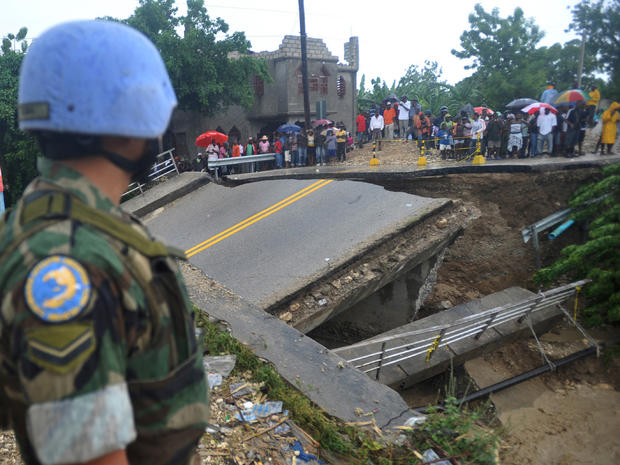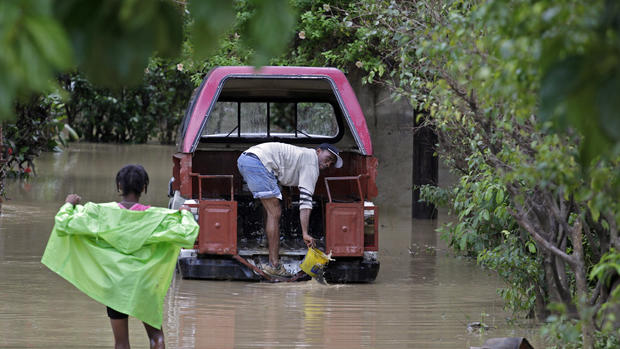Sandy claims at least 40 lives in Caribbean
Last Updated 3:14 p.m. ET
NASSAU, BAHAMAS Hurricane Sandy raged through the Bahamas early Friday after leaving 40 people dead across the Caribbean, following a path that could see it blend with a winter storm to hit the U.S. East Coast with a super-storm next week.
Sandy knocked out power, flooded roads and cut off islands in the storm-hardened Bahamas as it charged through Cat Island and Eleuthera, with authorities reporting one death in the scattered archipelago.
"Generally people are realizing it is serious," said Caroline Turnquest, head of the Red Cross in the Bahamas, who said 20 shelters were opened on the main island of New Providence.
Sandy, which weakened to a Category 1 hurricane Thursday night, caused havoc in Cuba Thursday, killing 11 people in eastern Santiago and Guantanamo provinces as its howling winds and rain toppled houses and ripped off roofs. Authorities said it was Cuba's deadliest storm since July 2005, when Category 5 Hurricane Dennis killed 16 people and caused $2.4 billion in damage.
The death toll was still rising in impoverished Haiti, reaching 26 on Friday as word of disasters reached officials and rains continued to fall.
Joseph Edgard Celestin, a spokesman for Haiti's civil protection office, said some people died trying to cross storm-swollen rivers. While the storm's center missed the country as it passed on Wednesday, Haiti's ramshackle housing and denuded hillsides make it especially vulnerable to flood damage.
Officials at a morgue in the western town of Grand Goave said a mudslide crashed through a wooden home on Thursday, killing 40-year-old Jacqueline Tatille and her four children, ranging in ages from 5 to 17.
"If the rain continues, for sure we'll have more people die," said morgue deputy Joseph Franck Laporte. "The earth cannot hold the rain."
Sandy also killed one person while battering Jamaica on Wednesday and police in the Bahamas said a 66-year-old man died after falling from his roof in upscale Lyford Cay late Thursday while trying to repair a window shutter.
In the Bahamas, power was out on Acklins Island and most roads there were flooded, government administrator Berkeley Williams said.
On Ragged Island in the southern Bahamas, the lone school was flooded.
"We have holes in roofs, lost shingles and power lines are down," said Charlene Bain, local Red Cross president. "But nobody lost a life, that's the important thing."
Russell, the emergency management official in Nassau, said docks on the western side of Great Inagua island had been destroyed and the roof of a government building was partially ripped off.
The huge Atlantis resort went into lockdown after dozens of tourists left Paradise Island before the airport closed, said George Markantonis, president of Kerzner International, which manages the resort. He said the resort was now less than half full, but all its restaurants, casinos and other facilities were still operating.
Sooner Halvorson, a 36-year-old hotel owner from Colorado who recently moved to the Bahamas, said she and her husband, Matt, expected to ride out the storm with their two young children, three cats, two dogs and a goat at their Cat Island resort.
"We brought all of our animals inside," she said, though she added that a horse stayed outside. "She's a 40-year-old horse from the island. She's been through tons of hurricanes."
On Great Exuma island, guest house operator Veronica Marshall supplied her only customer with a flashlight and some food before Sandy bore down. The storm-hardened Bahamian said she was confident that she and her business would make it through intact.
"I'm 73 years old and I've weathered many storms," she said.
- Hurricane lashes Bahamas after 21 deaths elsewhere
- Hurricane Sandy has potential to be super storm for U.S.
- Hurricane Sandy roars into Cuba
- Hurricane Sandy pounds Jamaica, eyes U.S.
Cuban authorities said the island's 11 dead included a 4-month-old boy who was crushed when his home collapsed and an 84-year-old man in Santiago province. Near the city of Guantanamo, the Communist Party daily Granma reported, two men were killed by falling trees.
Official news media reported Friday that the storm caused 5,000 houses to at least partially collapse while ripping the roofs off 30,000 others. Banana, coffee, bean and sugar crops were damaged.
According to the National Hurricane Center, as of 2:00 p.m. Friday Sandy was centered about 30 miles north-northeast of Great Abaco Island, or about 430 miles south-southeast of Charleston, S.C. The storm is moving north at 7 mph, with maximum sustained winds of 75 mph.
Government officials in the Bahamas said the storm seems to have inflicted the greatest damage on Cat Island, which took a direct hit, and Exuma, where there were reports of downed trees, power lines and damage to homes.
"I hope that's it for the year," said Veronica Marshall, a 73-year-old hotel owner in Great Exuma. "I thought we would be going into the night, but around 3 o'clock it all died down. I was very happy about that."
In Long Island, farmers lost most of their crops and several roofs were torn off, said legislator Loretta Butler-Turner. The island is without power and many residents do not have access to fresh water, she said.
With the storm projected to hit the Atlantic coast early Tuesday, there was a 90 percent chance that most of the U.S. East Coast would get steady gale-force winds, flooding, heavy rain and maybe snow starting Sunday and stretching past Wednesday, U.S. forecaster Jim Cisco said.
There were no reports of injuries at the U.S. naval base at Guantanamo Bay in Cuba, but there were downed trees and power lines, said Kelly Wirfel, a base spokeswoman. Officials canceled a military tribunal session scheduled for Thursday for the prisoner charged in the 2000 attack on the Navy destroyer USS Cole.
Officials reported flooding across Haiti, where many of the 370,000 people still displaced by the devastating 2010 earthquake scrambled for shelter. More than 1,000 people were evacuated from 11 quake settlements, according to the International Organization for Migration.
The stage is set for a meteorological mess as Hurricane Sandy continues to barrel north. A wintry storm is chugging across the country from the west. And frigid air is streaming south from Canada.
And if they meet Tuesday morning around New York or New Jersey, as forecasters predict, they could create a big, wet mass that settles over the nation's most heavily populated corridor and reaches as far west as Ohio.
"It's looking like a very serious storm that could be historic," said Jeff Masters, meteorology director of the forecasting service Weather Underground. "Mother Nature is not saying, 'Trick or treat.' It's just going to give tricks."
National Oceanic and Atmospheric Administration forecaster Jim Cisco, who coined the nickname "Frankenstorm" said: "We don't have many modern precedents for what the models are suggesting."
Government forecasters said there is a 90 percent chance -- up from 60 percent two days earlier -- that the East will get pounded.
Coastal areas from Florida to Maine will feel some effects, but the storm is expected to vent the worst of its fury on New Jersey and the New York City area, which could see around 5 inches of rain and gale-force winds close to 40 mph. Eastern Ohio, southwestern Pennsylvania and western Virginia could get snow.
And the storm will take its time leaving. The weather may not start clearing in the mid-Atlantic until the day after Halloween and Nov. 2 in the upper Northeast, Cisco said.
"It's almost a weeklong, five-day, six-day event," he said from a NOAA forecast center in College Park, Md. "It's going to be a widespread, serious storm."
It is likely to hit during a full moon, when tides are near their highest, increasing the risk of coastal flooding. And because many trees still have their leaves, they are more likely to topple in the event of wind and snow, meaning there could be widespread power outages lasting to Election Day.
Eastern states that saw outages that lasted for days after last year's freak Halloween snowstorm and Hurricane Irene in late August 2011 are already pressuring power companies to be more ready this time.
Asked if he expected utilities to be more prepared, Massachusetts Gov. Deval Patrick responded: "They'd better be."
Some have compared the tempest to the so-called Perfect Storm that struck off the coast of New England in 1991, but that one hit a less populated area. Nor is this one like last year's Halloween storm, which was merely an early snowfall.
"The Perfect Storm only did $200 million of damage and I'm thinking a billion" this time, Masters said. "Yeah, it will be worse."

